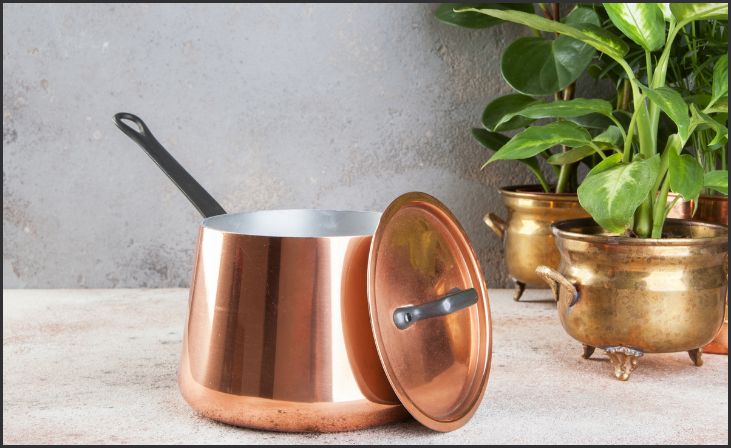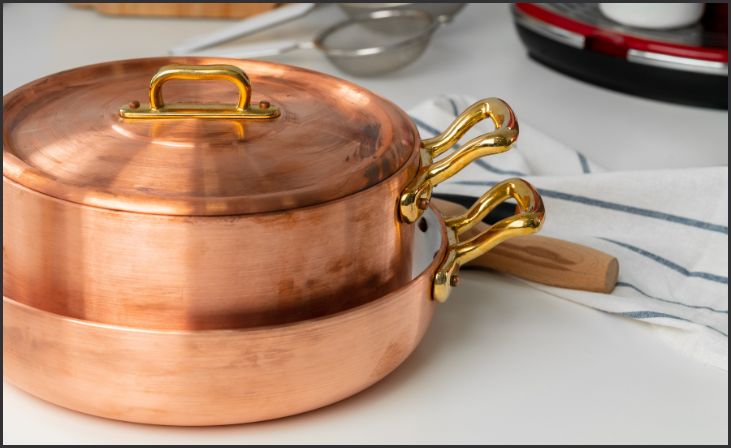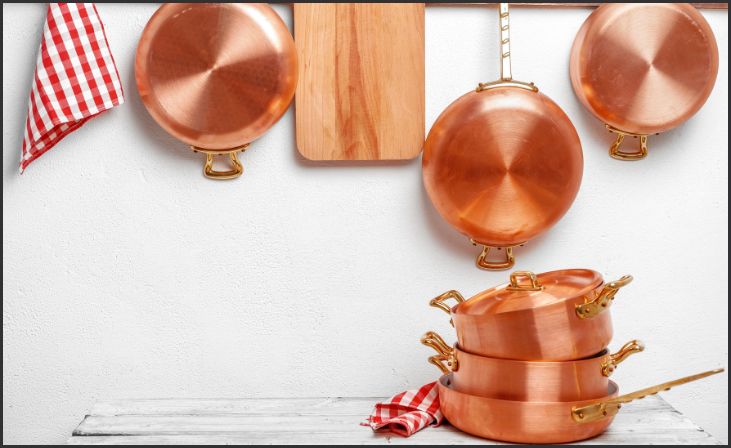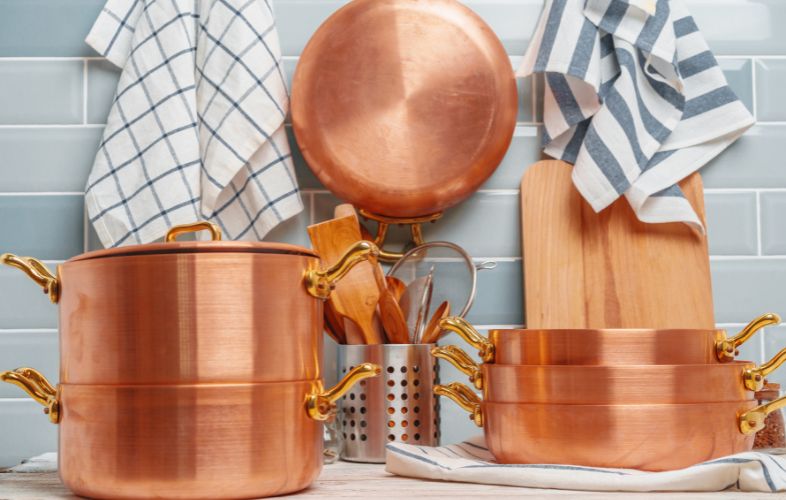Things To Know About Copper Cookware – Step into the realm of culinary mastery, where copper cookware commands the spotlight. In this extensive guide, we embark on a journey to unravel the diverse dimensions of copper cookware, delving into its unparalleled heat conductivity and timeless aesthetic charm.
Imagine a kitchen where every culinary creation is elevated to an art form, thanks to the magic of copper cookware. This guide serves as your passport to that culinary utopia, where precision meets elegance.
Let’s start our exploration with the remarkable attribute that sets copper apart in the culinary world – its unmatched heat conductivity. Picture the sizzle of ingredients meeting the surface of a copper pan, each element receiving an equal share of the heat. This unique property not only ensures precise temperature control but also transforms cooking into a seamless dance of flavors.
Copper, an elemental metal with a rich history dating back centuries, emerges as a culinary cornerstone for a myriad of compelling reasons. Its popularity in the realm of cookware is not merely a trend but a testament to its exceptional properties that chefs and home cooks alike find indispensable. Let’s explore the captivating allure that makes copper a preferred choice in kitchens around the world.
1. Material Matters: Understanding the Composition of Copper Cookware

Copper cookware transcends the boundaries of pure metal, often incorporating inner linings of stainless steel or tin. This composite design is a strategic choice, ensuring optimal cooking performance while mitigating potential reactivity concerns. The core, typically copper, provides unmatched heat conductivity, while the inner linings address any interaction between the copper and certain ingredients. This fusion of materials creates a harmonious blend, elevating your culinary endeavors by offering precise temperature control and versatility.
2. Seasoning Secrets: Enhancing Flavor Through Proper Seasoning
Seasoning copper cookware is akin to an art form, reminiscent of the traditions applied to cast iron. The process involves delicately coating the surface with a thin layer of oil and subjecting it to heat, creating a protective patina. This patina not only enhances the flavor profile of your dishes but also acts as a natural non-stick surface. Seasoning becomes a culinary ritual, infusing your copper cookware with character and charm, ensuring each meal is a testament to both technique and taste.
3. Cleaning Tips: Maintaining the Gleam of Copper Pans
Preserving the polished allure of copper cookware demands a careful approach. Mild dish soap, a soft sponge, and periodic polishing with a specialized copper cleaner become your tools in this culinary maintenance ritual. Gentle care is essential to safeguard the delicate surface of the cookware, ensuring it continues to gleam with an unmatched radiance. Avoiding abrasive materials is pivotal, preserving not only the aesthetics but also the integrity of the copper itself.
4. Versatility Unleashed: Exploring Different Culinary Applications
Copper cookware stands as a culinary chameleon, showcasing unparalleled versatility in the kitchen. Its superior heat conductivity transforms it into the ideal tool for tasks demanding precise temperature control—whether it’s the gentle sautéing of delicate ingredients or the hearty simmering of stews. Copper seamlessly adapts to the diverse challenges presented by various culinary applications, proving itself an indispensable ally in the pursuit of gastronomic excellence.
5. Durability Dynamics: Assessing the Longevity of Copper Cookware
While inherently durable, copper cookware thrives with mindful maintenance. Regular polishing becomes a ritual, preserving not just the aesthetics but the longevity of your culinary companions. Gentle cleaning practices, steering clear of harsh scouring pads, contribute to the enduring strength of your cookware. By treating your copper with care, it becomes more than a kitchen tool; it becomes a trusted companion, faithfully serving you in countless culinary adventures for years to come.
6. Culinary Chemistry: How Copper Reacts with Various Ingredients
Copper’s interaction with certain foods, especially acidic ones like tomatoes or citrus fruits, introduces an element of culinary chemistry. This reaction may result in a metallic taste or discoloration. To navigate this, consider copper cookware with a protective lining, such as stainless steel. This thoughtful choice mitigates the impact of culinary reactions, allowing you to harness the benefits of copper while maintaining the integrity of your dishes.
Also Read:- 18-FOOT SEA MONSTER
7. Budget Considerations: Balancing Quality and Affordability

When making an investment in copper cookware, quality and cost must be carefully balanced. Although investing in high-quality copper cookware initially costs more, the benefits include longer lifespans and better performance. An essential first step in striking the correct balance is evaluating your budget and gastronomic requirements. Think of it as an investment in your culinary adventure rather than merely a purchase, since copper’s timeless quality will become a mainstay in your kitchen, improving both the look and feel of your total cooking area.
Why Copper Cookware?
1. Unparalleled Heat Conductivity:
Copper boasts unmatched heat conductivity among common cookware materials. This means that when you adjust the temperature, copper responds swiftly, providing precise control over the cooking process. The result? Uniform heat distribution that ensures your culinary creations are cooked to perfection.
Also Read:- RARE BICENTENNIAL QUARTER
2. Precision in Temperature Control:

The ability of copper to respond rapidly to changes in temperature makes it an ideal choice for delicate cooking tasks. Whether you’re sautéing, simmering, or searing, copper cookware allows for precise adjustments, giving you a level of control that is crucial in achieving culinary excellence.
3. Aesthetic Elegance:
Beyond its functional attributes, copper brings a timeless elegance to the kitchen. The gleaming, warm tones of copper cookware elevate the visual appeal of any culinary space. From professional kitchens to home environments, the aesthetic charm of copper is a design choice that transcends trends.
4. Culinary Mastery:
Copper cookware isn’t just a tool; it’s an instrument of culinary mastery. The superior heat conductivity enhances your cooking skills, allowing you to execute recipes with finesse. It becomes an extension of the chef’s artistry, enabling a level of control that is essential for achieving perfection in every dish.
5. Versatility in Cooking Applications:
Copper adapts to a diverse range of cooking applications. Its versatility shines through whether you’re crafting delicate sauces, searing proteins, or simmering complex stews. This adaptability makes copper cookware a go-to choice for chefs who appreciate the flexibility it brings to their culinary repertoire.
Conclusion
Making copper cookware a staple in your kitchen transcends mere decision-making; it symbolizes a profound commitment to achieving culinary excellence. It’s not just about acquiring pots and pans; it’s an intentional choice to infuse your cooking space with a touch of sophistication and efficiency. So, let’s delve into the essence of this commitment and explore how embracing the brilliance of copper can elevate your cooking experience to unprecedented heights.
Imagine your kitchen as a culinary sanctuary, and copper cookware as the revered artisan within. This commitment goes beyond the utilitarian aspects of cookware; it’s about fostering a connection with your craft. As you introduce copper into your kitchen, you are essentially inviting a culinary companion that understands the nuances of your cooking endeavors.
FAQs
A: Absolutely! Copper cookware lined with stainless steel or tin is perfectly safe for daily cooking.
A: Mix equal parts vinegar and salt, create a paste, and gently scrub the stains away.

Leave a Reply